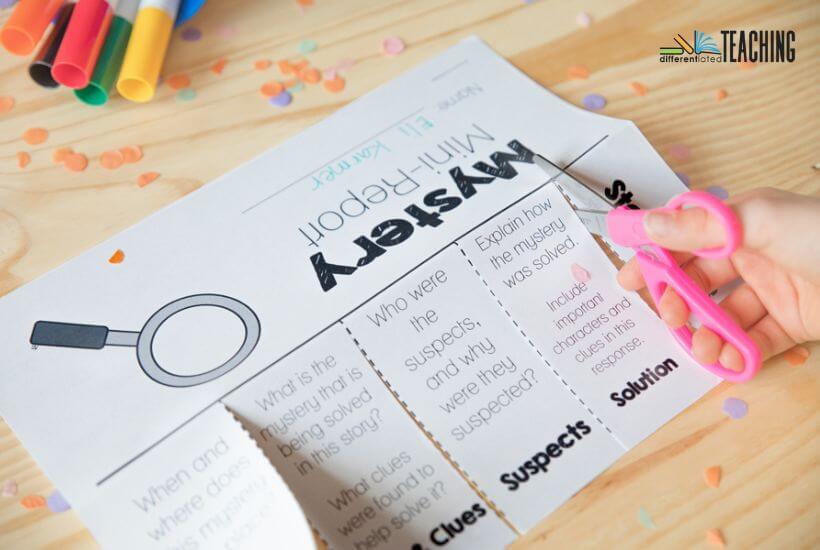How to Keep Independent Reading Time Accountable (Without Killing the Joy)
Independent reading is one of those routines that sounds like a dream — kids reading quietly, totally engaged in a book they love, while you work with small groups or tackle assessments.
But if you’ve ever looked up from your guided reading table to see three students flipping pages at light speed and one staring blankly at the carpet, you know: independent reading isn’t always as magical as we imagine.
And that’s okay.
It doesn’t mean you’re doing anything wrong; it just means kids need support to use that time well.
But here’s the good news: you don’t need to turn reading into a worksheet factory to make it meaningful. You don’t need daily reading logs or full-length book reports to check for understanding.
You just need a simple system that helps your students stay focused, think about their reading, and reflect in a way that’s developmentally appropriate and manageable for them and for you.
Let’s talk about how to build light, joyful accountability into your independent reading routine.
1. Give Students a Purpose Before They Read
The most powerful reading happens when students know what they’re looking for. Instead of sending them off with “read silently,” try giving a quick focus prompt like:
- “Look for a moment where the character changes.”
- “What’s one new fact you didn’t know before?”
- “What do you notice about how this story starts?”
This tiny shift in language builds the habit of intentional reading, and it doesn’t require anything fancy.
You can write it on the board, add it to a bookmark, or have students do a mini-lesson together in their reader’s notebook as a guiding question for the day. (Not using a notebook yet? Check out how I set up my independent reading notebooks here.)
2. Keep Post-Reading Reflections Short and Structured
This is where most independent reading routines start to fall apart.
When students finish a book, teachers often feel pressure to assign a big project or lengthy response to show accountability. But long, open-ended assignments tend to frustrate reluctant writers, overwhelm struggling readers, and burn everyone out.
Instead, try using short, structured formats, like foldable book report templates, that guide students to think about key elements of what they read:
- For fiction: What was the main problem? How did the character change? What genre traits did they notice?
- For nonfiction: What did they learn? What questions do they still have?
These responses can be completed in one or two sittings, and they’re far more meaningful than check-the-box summaries or generic graphic organizers.
Bonus: Foldables feel fun. The act of cutting, folding, and flipping through responses adds just enough novelty to keep students engaged, especially when reading independently.
3. Create a Weekly Rhythm That Works for Everyone
Consistency is key, but that doesn’t mean you need to collect a report every day.
Try building a simple rhythm like:
- Daily: Read & jot in a notebook
- Weekly: Complete one genre-specific flipbook or book response project
- Bi-weekly: Share with a partner, small group, or parent
This routine helps students internalize expectations without making reading feel like a constant assignment. And because the flipbooks are designed by genre, they naturally support your literacy instruction and help students think critically about text features and structure.
They also work well across reading levels, making them easy to implement in mixed-ability classrooms or homeschool families with more than one child.
Want to Try a Creative Reading Response Option?
If you’re looking for a fresh, low-pressure way to check in on your students’ independent reading, I’ve pulled one of my favorite templates from my book report pack just for you.
Download the Free Biography Flipbook
It’s perfect for nonfiction reading, whether you’re doing a biography unit, celebrating Women’s or Black History Month, or just adding more informational texts to your book basket.
Ready for Independent Reading Response Tasks Made Easy?
If you’re ready to stop reinventing the wheel every time your students finish a book, my Foldable Book Report Templates were made for you.
With 20 print-and-go templates that cover both fiction and nonfiction genres, these are perfect for:
- Independent reading check-ins
- Book clubs or small group follow-ups
- Homeschool reading projects
- Reading response centers or early finisher tasks
???? Grab the complete pack here
Genre Study + Independent Reading? Yes, Please.
Want to dig deeper into genre traits during independent reading? These flipbooks also work beautifully alongside your independent reading notebook system, giving students both freedom and structure to show what they’re learning.
No daily worksheets. No massive projects. Just thoughtful, simple reading response tools you’ll actually want to use.
Let Them Read — and Reflect
At the end of the day, the goal of independent reading isn’t perfect penmanship or multi-page reports. It’s growth — in confidence, comprehension, and the ability to think critically about texts.
With just a few intentional tweaks and tools like genre flipbooks or a consistent notebook routine, you can help students show what they know, without killing the joy of reading in the process.












